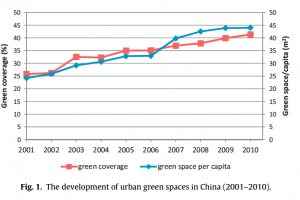timeline
Globally, urban green spaces are a relatively young concept. Worldwide, the first public parks were established in Europe and North America in the 18th and 19th centuries after the Industrial Revolution (Chen, 2013). Societal perspectives on environmental movements have since changed views of green spaces in city. In China, after economic reform policies post-1949, the urban environment became something significant in terms of urban planning and forming policies. Conceptualizing urban green space in China, due to influence from the West, grew to encompass not only an urban-centered focus, but also the wider ecological landscape (Chen, 2013).
Due to urbanization, China was forced to reconsider its urban landscapes and address environmental issues to preserve natural resources. China and its citizens are still dealing with the repercussions of their rapid modernization through natural land loss, biodiversity loss, and pollution, now common in all parts of the land ( Marks, 2012).
Green spaces by definition have carried different connotations over time.
In the beginning, green spaces were most frequently defined by citizens as open spaces with natural and public features (Xu et al., 2011). In China, conceptualizing green spaces in the early stages revolved around garden green spaces. This included public park green space, shelter green space, scenic green spaces, and traffic greenbelts. Recently, the perceptions of green spaces have expanded to include urban forest and urban farmland, in addition to urban green space gardens (Xu et al., 2011).

From the perspective of China’s economic development, the percent of urban green space coverage increases in the beginning stages of urbanization (Chen & Wang, 2013). As economic growth accelerates, urban green space coverage decreases due to insufficient greening policies. When the GDP per capita continues to grow, and wealthier urban populations demand natural amenities, then the percent of green space coverage begins to increase once again (Chen & Wang, 2013).
In Beijing, natural features of the city and the surrounding mountainous area were gravely threatened as the city developed.
Sui Dynasty: engineer projects such as the Great Canal and imperial roads, were developed at the cost of forest resources (Li, 1997).
1949: Beijing had only a 1.3% forest coverage rate (Li, 1997).
1950s + 1980s: Large-scale reforestation movements caused Beijing’s ecological condition to significantly improve.
1992: Beijing honored as one of China’s garden cities.
1994: Beijing increased the forest coverage rate to 31% (Li, 1997).
policy & implications
Similar to the Confucianist value of emulating successful individuals or processes in order to best gain knowledge, China has shaped its policies on urban green spaces and green cities on global ranking model cities (Pow et al., 2014). This means that China is trying to reach its “environmental targets by adopting measures and governmental rationalities proven elsewhere” (Pow et al., 2014, 134). This entails adopting a very Westernized view of policy implementation and green cities within themselves. For instance, the creation of these cities and spaces is very much driven by “entrepreneurial/commercial objectives and ideals of ecological modernisation” (Pow et al., 2014, 134). Being driven by the capitalist notions that the west prioritizes may put to the backburner some important improvements that may not necessarily be very economically beneficial but may have great environmental benefits (Pow et al., 2014). In addition, although these model cities have been able to achieve a lot of green improvements, these said improvements may not necessarily be successful for China (Pow et al., 2014). China has such a unique background and history with environmental degradation and a distinctly different culture than other societies, so in order for these policy adaptations of green spaces and cities to be successful, they have to not just use the framework of these successful cities, but adopt them to their specific localities and the wants and desires of their society. This often involves the mobilization of international planners, builders and policy experts as well as collaboration from Chinese municipal officers who referenced other cities to base theirs upon (Pow et al, 2014). Sometimes the local state of China itself comes up with these successful models, but for the most part, it is the work of international interests and simply modelled after without as much Chinese modification as could be done (Pow et al., 2014).
scope of problem
The geographic context of urban green spaces in China is limited to urban, metropolitan areas. Urban environments considered with ecological conditions and natural landscapes have prioritized urban green spaces as natural amenities. The demographics considered within the environmental issues of urban green spaces include populations living within Chinese cities. Largely, Chinese cities are monoracial (Zhao, 2013). Visit the section focusing on analysis of power and privilege to gain more insight on the specific demographic communities in regards to the distribution of urban green spaces.
Citations
Chen, C. (2013). Planning urban nature: urban green space planning in post-1949 China:
Beijing as a representative case study (Doctoral dissertation, Lincoln University). Retrieved from http://researcharchive.lincoln.ac.nz/handle/10182/5707
Chen, W. Y., & Wang, D. T. (2013). Economic development and natural amenity: An econometric analysis of urban green spaces in China. Urban forestry & urban greening, 12(4), 435-442. doi: 10.1016/j.ufug.2013.08.004
Li, M. (1997). Development of green space in Beijing. Ekistics, 64(385-387), 255. Retrieved from http://search.proquest.com/docview/232563402?accountid=10207
Marks, R. (2012). China its environment and history. Plymouth, UK: Rowman & Littlefield Publishers, Inc.
Pow, C., Neo, H. (2014). Modelling Green urbanism in China. Area, 47(2), 132–140, doi:10.1111/area.12128
Xu, X., Duan, X., Sun, H. et al. (2011) Green space changes and planning in the capital region of
China. Environmental management, 47(3), Environmental Management 47: 456-467 doi:10.1007/s00267-011-9626-3
Zhao, P. (2013). The impact of urban sprawl on social segregation in Beijing and a limited role for spatial planning. Tijdschrift voor economische en sociale geografie, 104(5), 571-587. doi: 10.1111/tesg.12030
